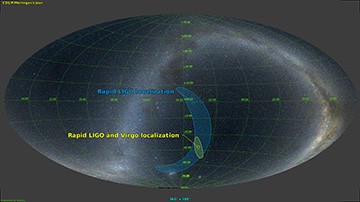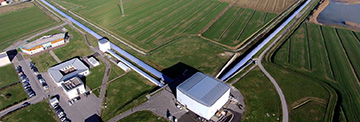The addition of Virgo to the mix of gravitational-wave observatories allowed a 20-fold sharpening of the ability to locate gravitational waves in the sky. [Image: LIGO/Virgo] [Enlarge image]
Since the first detection of gravitational waves by the Advanced Laser Interferometer Gravitational-wave Observatory (LIGO) was announced in early 2016, the project’s scientists and spokespersons have described a coming era of “multimessenger astronomy.” Such an astronomy, they suggested, would combine traditional sky observations in the electromagnetic spectrum with the entirely new, exotic data source embedded in gravitational waves.
Yesterday, researchers announced an important step toward making that vision a reality. At a meeting of the G7 science ministers in Turin, Italy, representatives of the LIGO-Virgo consortium reported the detection of another strong gravitational-wave signal, dubbed GW170814, by three widely separated gravitational-wave detectors—the two Advanced LIGO detectors in the United States, and the Advanced Virgo detector at the European Gravitational Observatory in Cascina, Italy.
The event marked the first time that gravitational waves had been observed by a detector beyond the two LIGO facilities (located in Hanford, Washington, and Livingston, Louisiana). Strictly speaking, the astrophysical event that gave rise to the waves—the collision of two black holes approximately 1.8 billion light-years away—was similar to those behind the three previous observations reported from the LIGO team. But having data from a third detector made the source of that event dramatically easier to locate in the sky, and added a new observational dimension by providing data on the polarization of the waves.
A 20-fold improvement in localization
France Córdova, the director of the U.S. National Science Foundation (NSF), LIGO’s major funder, noted that LIGO and Virgo started jointly gathering data at the beginning of August 2017, and the new detection followed almost immediately thereafter, on 14 August. Jo van den Brand, spokesperson for the Virgo project, noted that the signal was first detected by the LIGO Louisiana detector, and that it showed up 8 ms later at the Hanford detector and another 6 ms later at Virgo.
Because Einstein’s theory of general relativity holds that gravitational waves travel at the speed of light, van den Brand said, the time differences can be triangulated back to a “very accurate” determination just where the signal might be coming from. “With Virgo, we now have a three-detector network,” he said, “and through this triangulation, we can locate the source of these gravitational waves with a precision that is more than 20 times higher” than with the two LIGO detectors alone.
Online, the LIGO-Virgo team underscored that message with a striking sky map (above) comparing the large, arcuate sky region for the source assuming only the two LIGO detectors with the much tighter source localization when Virgo is added in. That better localization, van den Brand pointed out, will be particularly important as the three detectors begin to sample other kinds of astrophysical events (beyond the inherently “dark” phenomenon of black-hole collisions) that make their presence known in the electromagnetic spectrum.
“We expect that many such merger events will emit, besides gravitational waves, other messengers—for example light, or X-rays, or radio waves, or neutrinos or other subatomic particles,” he said. “Our vision is that our capabilities open this new field of multimessenger astronomy, and I think now we have taken the first step in that process.”
Polarization data debut
The Advanced Virgo detector in Italy. [Image: Virgo Collaboration] [Enlarge image]
Frédérique Marion of the Université Savoie Mont Blanc, France, noted that the addition of Virgo also creates an opportunity for a 3-D view of the gravitational-wave signal.
“When you add Virgo to the network, it not only improves the ability to locate sources in the sky in a dramatic way,” said Marion, “but it adds a new dimension to the fundamental tests that we can carry out.” That’s because, Marion went on, the Virgo facility’s different orientation relative to the LIGO sites provides access to the polarization of gravitational waves—“how spacetime is distorted in the three spatial dimensions as a gravitational wave propagates.”
Analysis of the polarization signal from this latest gravitational-wave detection, Marion said, allowed yet another test of the predictions of general relativity—and, once again, Einstein passed with flying colors. (Einstein’s theory predicts only two polarization modes in gravitational waves, and the data from GW170814 were consistent with that.) “But this is only the beginning,” Marion argued. “With a three-detector network, it really opens up a new potential, and we are going to make the most of that potential in the future.”
David Shoemaker, the spokesperson of the LIGO Scientific Collaboration, underscored the importance of adding Virgo to the mix. “The information that comes from positions is an amazing dimension,” he said. “This breakthrough announcement that we’re talking about today shows just what the synergy is between these three detectors.”
With the end of the first joint observing run on 25 August, Shoemaker added, the three detectors were turned off, and will enter a year-long maintenance period expected to double their detection sensitivity. That’s equivalent, he noted, to an eightfold increase in the volume of space that the detectors can sample.
An eye on funding
The paper reporting the results will be published in a future issue of Physical Review Letters. The timing of the pre-publication announcement is interesting, however, as it comes only a few days before the unveiling, this Monday, of the recipients of the 2017 Nobel Prize in Physics—and there is (as there was last year) a great deal of speculation that the nod will go to some of the scientists behind LIGO.
Yet the announcement’s timing and venue, coinciding with a meeting of the G7 science ministers, may have less to do with Nobel Prizes than with making the case for funding this behemoth, and expanding, scientific undertaking.
“It’s appropriate to realize that this … entirely new window on the universe has been made possible thanks to the commitment and the courage and the vision of our funding agencies,” said Virgo spokesperson van den Brand. “This is the type of long-term commitment that’s needed to open such a new window on the universe, and to achieve creating such a game-changing instrument.” He suggested that continued commitment will be necessary to follow through on the addition of other observatories in Japan and India to the global detector network, as well as on longer-term, “third-generation” projects such as the Einstein Telescope proposal in Europe and other efforts elsewhere.


